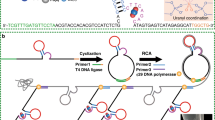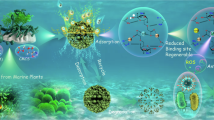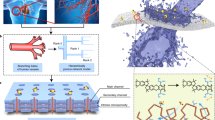Abstract
Seawater is the largest uranium reserve in the world, and the efficient extraction of uranium from seawater could facilitate the sustainable development of the nuclear industry for thousands of years. However, conventional extraction processes must suffer the dissociation of CO32− ions from [UO2(CO3)3]4− anions to bind the uranyl core, which has a high energy barrier, resulting in poor selectivity and long working times. Here we combine a molecular templating strategy to synthesize several hydroxy-rich covalent organic frameworks with tunable nanopore sizes. In the 1.2-nm-sized covalent organic framework cavity, hydroxyl groups coupled with the hydrogen-bonded NH4+ cations selectively bind uranyl tricarbonate ions via synergistic electrostatic and hydrogen-bonding interactions. This framework exhibits high uranium extraction capability with a removal ratio of > 99.99% in 400 min (initial concentration of 5 ppm at 298 K, pH = 8–9). Notably, a record uranium adsorption uptake is achieved with a capacity of 23.66 mg g−1 in seven days from natural seawater, surpassing that of classical amidoxime-based adsorbents by a factor of 350%.
This is a preview of subscription content, access via your institution
Access options
Subscribe to this journal
Receive 12 digital issues and online access to articles
118,99 € per year
only 9,92 € per issue
Buy this article
- Purchase on SpringerLink
- Instant access to full article PDF
Prices may be subject to local taxes which are calculated during checkout





Similar content being viewed by others
Data availability
The main data supporting the findings of this study are available within the article and its Supplementary Information files. Extra data are available from the corresponding author upon request.
References
Uranium 2020 (NEA & IAEA, 2021).
Yang, H. et al. Tuning local charge distribution in multicomponent covalent organic frameworks for dramatically enhanced photocatalytic uranium extraction. Angew. Chem. Int. Ed. 62, e202303129 (2023).
Xie, Y. et al. Uranium extraction from seawater: material design, emerging technologies and marine engineering. Chem. Soc. Rev. 52, 97–162 (2023).
Yang, W. et al. Functionalized iron–nitrogen–carbon electrocatalyst provides a reversible electron transfer platform for efficient uranium extraction from seawater. Adv. Mater. 33, 2106621 (2021).
Sun, Q. et al. Spatial engineering direct cooperativity between binding sites for uranium sequestration. Adv. Sci. 8, 2001573 (2021).
Rhodes, R. More nuclear power can speed CO2 cuts. Nature 548, 281 (2017).
Wu, Y. et al. Functional nanomaterials for selective uranium recovery from seawater: material design, extraction properties and mechanisms. Coord. Chem. Rev. 483, 215097 (2023).
Lindner, H. & Schneider, E. Review of cost estimates for uranium recovery from seawater. Energ. Econ. 49, 9–22 (2015).
Xiong, X. et al. Ammoniating covalent organic framework (COF) for high-performance and selective extraction of toxic and radioactive uranium ions. Adv. Sci. 6, 1900547 (2019).
Lashley, M. A. et al. Highly preorganized ligand 1,10-phenanthroline-2,9-dicarboxylic acid for the selective recovery of uranium from seawater in the presence of competing vanadium species. Inorg. Chem. 55, 10818–10829 (2016).
Liu, Z. et al. Anti-biofouling and water-stable balanced charged metal organic framework-based polyelectrolyte hydrogels for extracting uranium from seawater. ACS Appl. Mater. Interfaces 12, 18012–18022 (2020).
Liu, C. et al. A half-wave rectified alternating current electrochemical method for uranium extraction from seawater. Nat. Energy 2, 17007 (2017).
Cui, W. et al. Low band gap benzoxazole‐linked covalent organic frameworks for photo‐enhanced targeted uranium recovery. Small 17, 2006882 (2021).
Wang, Z. et al. Constructing an ion pathway for uranium extraction from seawater. Chem 6, 1683–1691 (2020).
Sun, Q. et al. Bio-inspired nano-traps for uranium extraction from seawater and recovery from nuclear waste. Nat. Commun. 9, 1644 (2018).
Mason, C. F. V. et al. Carbonate leaching of uranium from contaminated soils. Environ. Sci. Technol. 31, 2707–2711 (1997).
Santos, E. A. & Ladeira, A. C. Q. Recovery of uranium from mine waste by leaching with carbonate-based reagents. Environ. Sci. Technol. 8, 3591–3597 (2011).
Kaushik, A. et al. Large-area self-standing thin film of porous hydrogen-bonded organic framework for efficient uranium extraction from seawater. Chem 8, 2749–2765 (2022).
Wang, Y. et al. Adsorption of U(VI) from aqueous solution by the carboxyl-mesoporous carbon. Chem. Eng. J. 198, 246–253 (2012).
Chen, D. et al. Bio-inspired functionalization of electrospun nanofibers with anti-biofouling property for efficient uranium extraction from seawater. Chem. Eng. J. 465, 142844 (2023).
Song, Y. et al. Nanospace decoration with uranyl-specific ‘hooks’ for selective uranium extraction from seawater with ultrahigh enrichment index. ACS Cent. Sci. 7, 1650–1656 (2021).
Feng, L. et al. In situ synthesis of uranyl‐imprinted nanocage for selective uranium recovery from seawater. Angew. Chem. Int. Ed. 61, e202101015 (2022).
Guo, X. et al. DFT investigations of uranium complexation with amidoxime-, carboxyl-and mixed amidoxime/carboxyl-based host architectures for sequestering uranium from seawater. Inorg. Chim. Acta 441, 117–125 (2016).
Gan, J. et al. Phosphorylation improved the competitive U/V adsorption on chitosan-based adsorbent containing amidoxime for rapid uranium extraction from seawater. Int. J. Biol. Macromol. 238, 124074 (2023).
Wang, Z. et al. Constructing uranyl-specific nanofluidic channels for unipolar ionic transport to realize ultrafast uranium extraction. J. Am. Chem. Soc. 143, 14523–14529 (2021).
Wang, D. et al. Significantly enhanced uranium extraction from seawater with mass produced fully amidoximated nanofiber adsorbent. Adv. Energy Mater. 8, 1802607 (2018).
Yuan, Y. et al. Rational design of porous nanofiber adsorbent by blow‐spinning with ultrahigh uranium recovery capacity from seawater. Adv. Funct. Mater. 29, 1805380 (2019).
Chandra, S. et al. Molecular level control of the capacitance of two-dimensional covalent organic frameworks, role of hydrogen bonding in energy storage materials. Chem. Mater. 29, 2074–2080 (2017).
Liang, Y. et al. Guanidinium-based ionic covalent organic frameworks for capture of uranyl tricarbonate. Adv. Compos. Hybrid Mater. 5, 184–194 (2022).
Cao, Q. et al. A study of the potential application of nano-Mg(OH)2 in adsorbing low concentrations of uranyl tricarbonate from water. Nanoscale 4, 2423–2430 (2012).
Haarmann, N. et al. Modeling of interfacial tensions of long-chain molecules and related mixtures using perturbed chain-statistical associating fluid theory and the density gradient theory. J. Chem. Eng. Data 65, 1005–1018 (2019).
Li, J. et al. Does polysaccharide is an idea template selection for glycosyl imprinting. Biosens. Bioelectron. 99, 438–442 (2018).
Huang, Y. et al. Strategy of choosing templates in molecular imprinting to expand the recognition width for family-selectivity. Anal. Chem. 95, 11070–11077 (2023).
Maia, R. A. et al. Crystal engineering of covalent organic frameworks based on hydrazine and hydroxy-1,3,5-triformylbenzenes. Cryst. Growth Des. 18, 5682–5689 (2018).
Yi, S. et al. Ionic liquid modified covalent organic frameworks for efficient detection and adsorption of ReO4–/TcO4–. J. Environ. Chem. Eng. 10, 107666 (2022).
Jiang, Y. et al. Stainless-steel-net-supported superhydrophobic COF coating for oil/water separation. J. Membr. Sci. 587, 117177 (2019).
Mu, Z. et al. Zwitterionic covalent organic frameworks as catalysts for hierarchical reduction of CO2 with amine and hydrosilane. ACS Appl. Mater. Interfaces 10, 41350–41358 (2018).
Yuan, Y. et al. Molecularly imprinted porous aromatic frameworks and their composite components for selective extraction of uranium ions. Adv. Mater. 30, 1706507 (2018).
Zeppuhar, A. N. et al. Linkage transformations in a three-dimensional covalent organic framework for high-capacity adsorption of perfluoroalkyl substances. ACS Appl. Mater. Interfaces 15, 28476–28490 (2023).
Humphrey, W. et al. VMD: visual molecular dynamics. J. Mol. Graph. 14, 33–38 (1996).
Liu, T. et al. Multiwfn: a multifunctional wavefunction analyzer. J. Comput. Chem. 33, 580–592 (2012).
Liu, T. et al. A comprehensive electron wavefunction analysis toolbox for chemists, Multiwfn. J. Chem. Phys. 161, 082503 (2024).
Halder, A. et al. Ultrastable imine-based covalent organic frameworks for sulfuric acid recovery, an effect of interlayer hydrogen bonding. Angew. Chem. Int. Ed. 57, 5797–5802 (2018).
Zhang, D. et al. Highly efficient extraction of uranium from seawater by polyamide and amidoxime co-functionalized MXene. Environ. Pollut. 317, 120826 (2023).
Sunder, S. & Miller, N. H. XPS and XRD studies of (Th,U)O2 fuel corrosion in water. J. Nucl. Mater. 279, 118–126 (2000).
Zhong, X. et al. The role of functional-group-tuning in adsorption-photoreduction of U(VI) onto β-ketoenamine covalent organic frameworks photosystem. Chem. Eng. J. 467, 143415 (2023).
Qiu, J. et al. Porous covalent organic framework based hydrogen‐bond nanotrap for the precise recognition and separation of gold. Angew. Chem. Int. Ed. 135, e202300459 (2023).
Shi, Y. et al. Anchoring LiCl in the nanopores of metal-organic frameworks for ultra‐high uptake and selective separation of ammonia. Angew. Chem. Int. Ed. 61, 202212032 (2022).
Lohse, M. S. et al. Sequential pore wall modification in a covalent organic framework for application in lactic acid adsorption. Chem. Mater. 28, 626–631 (2016).
Zhou, L. et al. Suppressing hydrogen evolution in aqueous lithium-ion batteries with double-site hydrogen bonding. ACS Energy Lett. 8, 40–47 (2022).
Xu, X. et al. Ultrahigh and economical uranium extraction from seawater via interconnected open-pore architecture poly(amidoxime) fiber. J. Mater. Chem. A 8, 22032–22044 (2020).
Yuan, Y. et al. Ultrafast and highly selective uranium extraction from seawater by hydrogel-like spidroin-based protein fiber. Angew. Chem. Int. Ed. 131, 11911–11916 (2019).
Yuan, Y. et al. A bio‐inspired nano‐pocket spatial structure for targeting uranyl capture. Angew. Chem. Int. Ed. 59, 4262–4268 (2020).
Wang, N. et al. Accelerated chemical thermodynamics of uranium extraction from seawater by plant‐mimetic transpiration. Adv. Sci. 8, 2102250 (2021).
Zhang, C.-R. et al. Alkynyl-based sp2 carbon-conjugated covalent organic frameworks with enhanced uranium extraction from seawater by photoinduced multiple effects. CCS Chem. 3, 168–179 (2021).
Feng, X. et al. Highly efficient extraction of uranium from seawater by natural marine crab carapace. Chem. Eng. J. 430, 133038 (2022).
Yuan, Y. et al. High-capacity uranium extraction from seawater through constructing synergistic multiple dynamic bonds. figshare https://doi.org/10.6084/m9.figshare.25358452 (2024).
Acknowledgements
G.Z. was supported by the National Key R&D Program of China (grant number 2022YFB3805902), the National Natural Science Foundation of China (grant numbers 22131004 and U21A20330) and the ‘111’ project (grant number B18012). Y. Yuan was supported by the National Natural Science Foundation of China (grant numbers 21975039 and 22322501), the Fundamental Research Funds for the Central Universities (grant numbers 2412020ZD008 and GFPY202309) and the CNNC Key Laboratory on Uranium Extraction from Seawater (KLUES202202). Y. Yang was supported by the National Natural Science Foundation of China (grant number 52204389).
Author information
Authors and Affiliations
Contributions
Y. Yuan and D.C. helped design the experiments and wrote portions of the paper. D.C. carried out the experiments and performed the data interpretation. F.C., C.Z. and J.C. conducted the theoretical calculations. Y. Yang helped design the experiments. Yingbo Song, Y.Z., S.C., Yan Song and F.W. performed the characterizations for uranium adsorption. Y. Yuan and G.Z. developed the concept, supervised the experiments and drafted the paper.
Corresponding author
Ethics declarations
Competing interests
The authors declare no competing interests.
Peer review
Peer review information
Nature Water thanks Shengqian Ma and the other, anonymous, reviewer(s) for their contribution to the peer review of this work.
Additional information
Publisher’s note Springer Nature remains neutral with regard to jurisdictional claims in published maps and institutional affiliations.
Supplementary information
Supplementary Information
Supplementary Figs. 1–57 and Tables 1–16.
Rights and permissions
Springer Nature or its licensor (e.g. a society or other partner) holds exclusive rights to this article under a publishing agreement with the author(s) or other rightsholder(s); author self-archiving of the accepted manuscript version of this article is solely governed by the terms of such publishing agreement and applicable law.
About this article
Cite this article
Yuan, Y., Cao, D., Cui, F. et al. High-capacity uranium extraction from seawater through constructing synergistic multiple dynamic bonds. Nat Water 3, 89–98 (2025). https://doi.org/10.1038/s44221-024-00346-y
Received:
Accepted:
Published:
Issue Date:
DOI: https://doi.org/10.1038/s44221-024-00346-y
This article is cited by
-
Bipolar electrochemical uranium extraction from seawater with ultra-low cell voltage
Nature Sustainability (2025)



